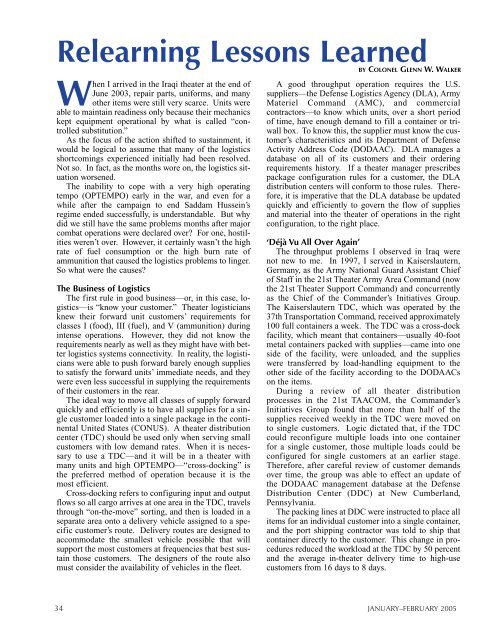Supporting the First Stryker Brigade in Iraq - Army Logistics ...
Supporting the First Stryker Brigade in Iraq - Army Logistics ...
Supporting the First Stryker Brigade in Iraq - Army Logistics ...
You also want an ePaper? Increase the reach of your titles
YUMPU automatically turns print PDFs into web optimized ePapers that Google loves.
Relearn<strong>in</strong>g Lessons Learned<br />
BY COLONEL GLENN W. WALKER<br />
When I arrived <strong>in</strong> <strong>the</strong> <strong>Iraq</strong>i <strong>the</strong>ater at <strong>the</strong> end of<br />
June 2003, repair parts, uniforms, and many<br />
o<strong>the</strong>r items were still very scarce. Units were<br />
able to ma<strong>in</strong>ta<strong>in</strong> read<strong>in</strong>ess only because <strong>the</strong>ir mechanics<br />
kept equipment operational by what is called “controlled<br />
substitution.”<br />
As <strong>the</strong> focus of <strong>the</strong> action shifted to susta<strong>in</strong>ment, it<br />
would be logical to assume that many of <strong>the</strong> logistics<br />
shortcom<strong>in</strong>gs experienced <strong>in</strong>itially had been resolved.<br />
Not so. In fact, as <strong>the</strong> months wore on, <strong>the</strong> logistics situation<br />
worsened.<br />
The <strong>in</strong>ability to cope with a very high operat<strong>in</strong>g<br />
tempo (OPTEMPO) early <strong>in</strong> <strong>the</strong> war, and even for a<br />
while after <strong>the</strong> campaign to end Saddam Husse<strong>in</strong>’s<br />
regime ended successfully, is understandable. But why<br />
did we still have <strong>the</strong> same problems months after major<br />
combat operations were declared over? For one, hostilities<br />
weren’t over. However, it certa<strong>in</strong>ly wasn’t <strong>the</strong> high<br />
rate of fuel consumption or <strong>the</strong> high burn rate of<br />
ammunition that caused <strong>the</strong> logistics problems to l<strong>in</strong>ger.<br />
So what were <strong>the</strong> causes?<br />
The Bus<strong>in</strong>ess of <strong>Logistics</strong><br />
The first rule <strong>in</strong> good bus<strong>in</strong>ess—or, <strong>in</strong> this case, logistics—is<br />
“know your customer.” Theater logisticians<br />
knew <strong>the</strong>ir forward unit customers’ requirements for<br />
classes I (food), III (fuel), and V (ammunition) dur<strong>in</strong>g<br />
<strong>in</strong>tense operations. However, <strong>the</strong>y did not know <strong>the</strong><br />
requirements nearly as well as <strong>the</strong>y might have with better<br />
logistics systems connectivity. In reality, <strong>the</strong> logisticians<br />
were able to push forward barely enough supplies<br />
to satisfy <strong>the</strong> forward units’ immediate needs, and <strong>the</strong>y<br />
were even less successful <strong>in</strong> supply<strong>in</strong>g <strong>the</strong> requirements<br />
of <strong>the</strong>ir customers <strong>in</strong> <strong>the</strong> rear.<br />
The ideal way to move all classes of supply forward<br />
quickly and efficiently is to have all supplies for a s<strong>in</strong>gle<br />
customer loaded <strong>in</strong>to a s<strong>in</strong>gle package <strong>in</strong> <strong>the</strong> cont<strong>in</strong>ental<br />
United States (CONUS). A <strong>the</strong>ater distribution<br />
center (TDC) should be used only when serv<strong>in</strong>g small<br />
customers with low demand rates. When it is necessary<br />
to use a TDC—and it will be <strong>in</strong> a <strong>the</strong>ater with<br />
many units and high OPTEMPO—“cross-dock<strong>in</strong>g” is<br />
<strong>the</strong> preferred method of operation because it is <strong>the</strong><br />
most efficient.<br />
Cross-dock<strong>in</strong>g refers to configur<strong>in</strong>g <strong>in</strong>put and output<br />
flows so all cargo arrives at one area <strong>in</strong> <strong>the</strong> TDC, travels<br />
through “on-<strong>the</strong>-move” sort<strong>in</strong>g, and <strong>the</strong>n is loaded <strong>in</strong> a<br />
separate area onto a delivery vehicle assigned to a specific<br />
customer’s route. Delivery routes are designed to<br />
accommodate <strong>the</strong> smallest vehicle possible that will<br />
support <strong>the</strong> most customers at frequencies that best susta<strong>in</strong><br />
those customers. The designers of <strong>the</strong> route also<br />
must consider <strong>the</strong> availability of vehicles <strong>in</strong> <strong>the</strong> fleet.<br />
34<br />
A good throughput operation requires <strong>the</strong> U.S.<br />
suppliers—<strong>the</strong> Defense <strong>Logistics</strong> Agency (DLA), <strong>Army</strong><br />
Materiel Command (AMC), and commercial<br />
contractors—to know which units, over a short period<br />
of time, have enough demand to fill a conta<strong>in</strong>er or triwall<br />
box. To know this, <strong>the</strong> supplier must know <strong>the</strong> customer’s<br />
characteristics and its Department of Defense<br />
Activity Address Code (DODAAC). DLA manages a<br />
database on all of its customers and <strong>the</strong>ir order<strong>in</strong>g<br />
requirements history. If a <strong>the</strong>ater manager prescribes<br />
package configuration rules for a customer, <strong>the</strong> DLA<br />
distribution centers will conform to those rules. Therefore,<br />
it is imperative that <strong>the</strong> DLA database be updated<br />
quickly and efficiently to govern <strong>the</strong> flow of supplies<br />
and material <strong>in</strong>to <strong>the</strong> <strong>the</strong>ater of operations <strong>in</strong> <strong>the</strong> right<br />
configuration, to <strong>the</strong> right place.<br />
‘Déjà Vu All Over Aga<strong>in</strong>’<br />
The throughput problems I observed <strong>in</strong> <strong>Iraq</strong> were<br />
not new to me. In 1997, I served <strong>in</strong> Kaiserslautern,<br />
Germany, as <strong>the</strong> <strong>Army</strong> National Guard Assistant Chief<br />
of Staff <strong>in</strong> <strong>the</strong> 21st Theater <strong>Army</strong> Area Command (now<br />
<strong>the</strong> 21st Theater Support Command) and concurrently<br />
as <strong>the</strong> Chief of <strong>the</strong> Commander’s Initiatives Group.<br />
The Kaiserslautern TDC, which was operated by <strong>the</strong><br />
37th Transportation Command, received approximately<br />
100 full conta<strong>in</strong>ers a week. The TDC was a cross-dock<br />
facility, which meant that conta<strong>in</strong>ers—usually 40-foot<br />
metal conta<strong>in</strong>ers packed with supplies—came <strong>in</strong>to one<br />
side of <strong>the</strong> facility, were unloaded, and <strong>the</strong> supplies<br />
were transferred by load-handl<strong>in</strong>g equipment to <strong>the</strong><br />
o<strong>the</strong>r side of <strong>the</strong> facility accord<strong>in</strong>g to <strong>the</strong> DODAACs<br />
on <strong>the</strong> items.<br />
Dur<strong>in</strong>g a review of all <strong>the</strong>ater distribution<br />
processes <strong>in</strong> <strong>the</strong> 21st TAACOM, <strong>the</strong> Commander’s<br />
Initiatives Group found that more than half of <strong>the</strong><br />
supplies received weekly <strong>in</strong> <strong>the</strong> TDC were moved on<br />
to s<strong>in</strong>gle customers. Logic dictated that, if <strong>the</strong> TDC<br />
could reconfigure multiple loads <strong>in</strong>to one conta<strong>in</strong>er<br />
for a s<strong>in</strong>gle customer, those multiple loads could be<br />
configured for s<strong>in</strong>gle customers at an earlier stage.<br />
Therefore, after careful review of customer demands<br />
over time, <strong>the</strong> group was able to effect an update of<br />
<strong>the</strong> DODAAC management database at <strong>the</strong> Defense<br />
Distribution Center (DDC) at New Cumberland,<br />
Pennsylvania.<br />
The pack<strong>in</strong>g l<strong>in</strong>es at DDC were <strong>in</strong>structed to place all<br />
items for an <strong>in</strong>dividual customer <strong>in</strong>to a s<strong>in</strong>gle conta<strong>in</strong>er,<br />
and <strong>the</strong> port shipp<strong>in</strong>g contractor was told to ship that<br />
conta<strong>in</strong>er directly to <strong>the</strong> customer. This change <strong>in</strong> procedures<br />
reduced <strong>the</strong> workload at <strong>the</strong> TDC by 50 percent<br />
and <strong>the</strong> average <strong>in</strong>-<strong>the</strong>ater delivery time to high-use<br />
customers from 16 days to 8 days.<br />
JANUARY–FEBRUARY 2005







